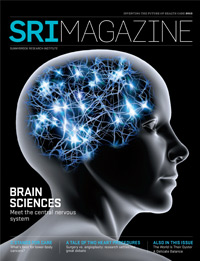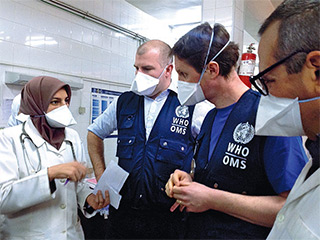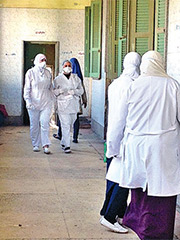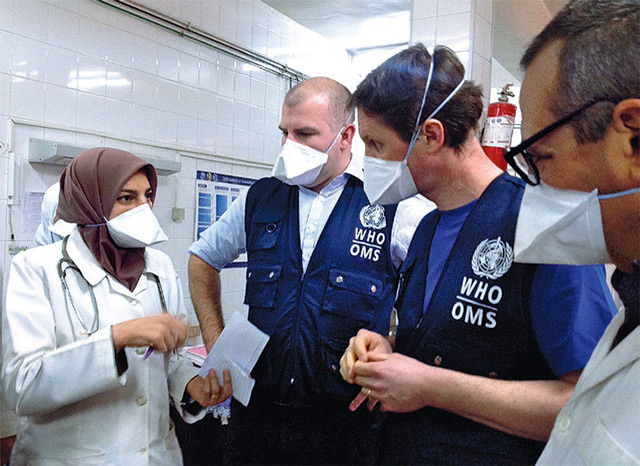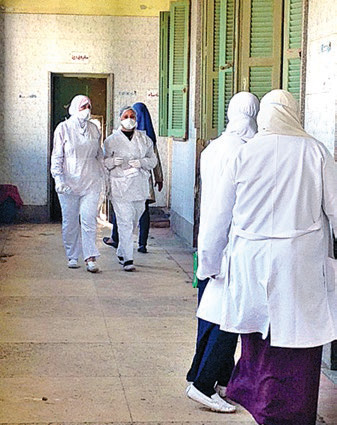Pandemic Readiness
The MERS-CoV and H7N9 bird flu virus have emerged in humans and caused severe illness, death and fear of an outbreak. Experts caution we need to be prepared—not only as doctors, but also as researchers
Critical care physician Dr. Robert Fowler is at the frontlines of medical research when new life-threatening infectious diseases strike around the world. In the spring of 2009 when the H1N1 influenza pandemic emerged globally, Fowler and his research team at Sunnybrook Research Institute (SRI) led the first studies to describe what the virus looked like, and help doctors and hospitals to prepare better for future outbreaks.
“Being prepared ahead of time for pandemics and epidemics is critical, because otherwise a lot of real-time research can’t happen, as it takes too long to get regulatory startup procedures done,” says Fowler, who is a senior scientist in the Tory Trauma Research Program at SRI and an associate professor at the University of Toronto.
This past year, Fowler has been working with a group of researchers on a combination of emerging severe acute respiratory infection etiologies at the World Health Organization’s department of pandemic and epidemic diseases in Geneva, Switzerland. The department provides clinicians with guidance in the diagnosis and treatment of infected patients using standard protocols and research guidelines. The purpose is to enable better global pandemic preparedness to reduce the impact of infectious diseases on affected populations and limit their spread internationally.

Virus Facts
- H7N9 is one subgroup among the larger group of H7 avian influenza viruses (H7N2, H7N3, and H7N7) that normally circulate among birds.
- MERS-CoV is a coronavirus from the same large family of viruses that includes SARS.
- This is the first time infection with viruses H7N9 and MERS-CoV have been found in humans.
- There are no travel restrictions to China and Middle Eastern countries.
- Hand and respiratory hygiene are prudent to prevent infection of H7N9 and MERS-CoV.
Sources: the Public Health Agency of Canada and the World Health Organization
Fowler and colleagues are looking at two infections that emerged only in the last one-and-a-half years: avian influenza A (H7N9) virus, which broke out mainly in eastern China; and the Middle East respiratory syndrome coronavirus (MERS-CoV), which was found in Saudi Arabia and surrounding regions, as well as some European countries and Tunisia, North Africa. Both viruses have caused severe human illness and admission of patients to intensive care units.
Unlike the common cold or seasonal influenza, which infect 10% to 20% of the population each year and have relatively low death rates, the H7N9 virus has a 35% to 40% risk of death. Most cases are male with a median age of 60 years. Researchers have found the virus is transmissible to humans from direct contact with infected poultry or indirect contact with contaminated environments, such as poultry markets. Common symptoms include fever, cough and shortness of breath, but most patients experience rapid progression to severe pneumonia. Patients are treated with anti-influenza drugs known as neuraminidase inhibitors, such as Tamiflu. Although human-to-human spread has not been a prominent aspect of this outbreak, that is the big worry, says Fowler.
“A virus like H7N9 mutates a bit, develops a better ability to be transmitted, [and] then you have the workings of something that is a real problem because it kills a lot of people even with the best therapy we have,” says Fowler.
Camels are the most common host of MERS-CoV.
He notes that if the virus develops resistance to the usual drugs prescribed, then, unsurprisingly, the case fatality rate will be higher. Fowler and his team are collaborating with groups in China to understand the illness better and encourage research support to conduct observational studies and clinical trials with people infected with the H7N9 virus to improve treatment.
In the Middle East, MERS-CoV is a coronavirus similar to SARS, a severe acute respiratory syndrome that struck globally in 2003 and infected more than 8,000 people, with 774 reported deaths. The case fatality rate of MERS-CoV carries a similar risk of death as the H7N9 virus: 40%. Researchers have found that camels are the most common host of the MERS-CoV due to the large camel trade in the region; this could have a substantial financial impact on the industry, Fowler notes, as happened with bovine spongiform encephalopathy, or “mad cow disease,” which caused stocks of cattle to be recalled worldwide.
There is no vaccine or antiviral drug for MERS-CoV, says Fowler; treatment is limited to supportive care in the intensive care unit. His team also established a collaborative research program among affected countries to determine which institutions in surrounding areas could facilitate observational and experimental research for patients who are critically ill. The aim is to identify and then provide patients with a more targeted treatment for the illness.
Researchers are looking at convalescent plasma therapy as the most promising potential treatment. This technique involves extracting antibodies either from survivors who have been exposed to MERS-CoV or from animals that have been inoculated with MERS-CoV, and making a concentrated antibody formulation that is delivered to infected patients.
“Our goal is to develop a randomized controlled trial of this therapy for viruses like MERS-CoV amid all the challenges that go along with the science and the culture of research in different areas,” Fowler says. “This is research at the front end, trying to establish the capacity to do research in clinical trials in resource-challenged areas.”
Domestically, Fowler is working with the Public Health Agency of Canada to become “research-ready” with pre-vetted protocols so that Canada can lead the global charge when needed, he says. Fowler aims to expedite studies by having research ethics board preapprovals in place at hospitals across the country, along with signed data-sharing agreements between hospitals and organizations like SRI leading this research. If regulatory procedures that normally take up to a year to process are completed in advance, then doctors could begin to describe the illness and conduct clinical trials on antiviral drugs and other respiratory therapies immediately.
“We need to evolve much better ways to do research quickly, and to have observational studies and clinical trial protocols that might be focused on the most common interventions all ready to go before they happen. If we don’t adopt that model, we will not be able to respond effectively—if you are not ready to do research, then you will have disastrous consequences,” says Fowler.
When asked if Canada is prepared, he says doctors and health care professionals are equipped better than before because of their experience with SARS and H1N1.
“From a perspective of surveillance and epidemiology, infection prevention control and clinical response, we are better prepared,” Fowler says. “However, from a research perspective, are we better prepared to undertake things in real time? No, we’re not. That’s what I’m trying to promote and advocate, so that we’re ready when things do happen because they will, probably with increased frequency.”
— Eleni Kanavas
Fowler’s research is funded by the Canadian Institutes of Health Research, the Heart and Stroke Foundation of Ontario and the Public Health Agency of Canada, and is being done in collaboration with the World Health Organization.

